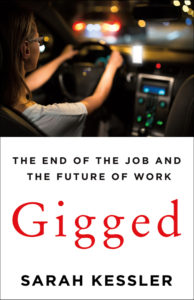The Gig Economy: Lower Wages, More Injuries, Horrible Benefits
It's Worse Than You Think
As the gig economy aged, it became clear that independence, flexibility, and freedom were not its only characteristics—that the experience wasn’t wonderful for everyone.
One of the most startling reports was Washington Post reporter Lydia Depillis’s September 2014 profile of an independent cleaner named Anthony Walker. In it, Walker dropped his four-year-old daughter off at daycare and dragged a roller bag full of cleaning supplies onto a Washington, DC city bus, which he rode for more than two hours before reaching the home he’d been assigned to clean. The job, assigned to him by the gig economy company Homejoy, paid $51, which meant that, including five hours of commute time, Walker made around $10 per hour—before any taxes had been withheld and without any workers’ compensation, unemployment, time off, or retirement benefits. This was better than nothing, perhaps, but it didn’t look much like the story that Silicon Valley had been telling about the gig economy.
Throughout 2014 and 2015, stories like these made it hard to accept the idealistic idea that the gig economy would provide quality on-demand work in an economy in which good jobs were becoming harder to find. There were reports of drivers who had been deactivated from Uber without explanation. Cleaners for Homejoy who didn’t earn enough to pay rent. And couriers who worked for gig economy delivery companies like Postmates and Deliveroo who didn’t clear the minimum wage.
“I think Deliveroo wants to manufacture this image that we are all young, middle-class men who wear trendy clothes, making a little extra cash,” one courier told The Guardian. “But a lot of the couriers are migrants, or working-class people from the local area, and the majority are doing it full-time because they need the money.” (Deliveroo told the paper that 85 percent of its fleet used the gig as supplemental income.)
Workers in the gig economy were disproportionately poor. Compared with the American population, about twice as many gig economy workers earned less than $30,000 per year, below what MIT calculates to be the US living wage for a family of four. In New York City, where the living wage for a family of four is $46,000 in a year, a group that said it represents 50,000 ride-hail drivers told the New York Times that more than one-fifth of its members earned less than $30,000 in a year, before expenses. When gig economy leaders had conveyed their visions early on, they had failed to distinguish between the experiences of people with relatively scarce skills—freelance graphic designers, journalists, movie production crews, programmers—and those with less scarce skills, like house cleaners and drivers and Mechanical Turk workers.
As a group, independent contractors earn more than employees who do similar work. Many of them are highly skilled freelancers like Curtis, the New York City-based programmer, and make six-figure salaries or more. But low-wage workers have historically been hurt rather than helped by the trend away from employees. One study found that contracted cleaners and security guards earned 15 percent less and 17 percent less, respectively, than their in-house peers. Another study found that the “outsourcing wage penalty” ranges between 4 percent and 7 percent for janitors and between 8 percent and 24 percent for guards. Both groups were less likely to receive benefits than their counterparts with direct-employment ties to their work.
“Gig economy champions are fond of touting data that shows that workers like flexibility. But this data doesn’t take into consideration how much workers value this flexibility when weighed against factors like pay, job security, benefits, and safety.”
A report published by the US Government and Accountability office in 2015 found that contingent workers across the board—a category that includes temp workers and subcontracted workers in addition to freelancers—earned about 10.6 percent less per hour than “standard workers,” and were about two-thirds less likely to have a work-provided retirement savings plan. “These contingent workers are also more likely than standard workers to experience job instability, and to be less satisfied with their benefits and employment arrangements than standard full-time workers,” wrote the report’s authors. “Because contingent work can be unstable, or may afford fewer worker protections depending on a worker’s particular employment arrangement, it tends to lead to lower earnings, fewer benefits, and a greater reliance on public assistance than standard work.”
The economist David Weil argues in his book The Fissured Workplace that there are several reasons workers’ pay and benefits are stronger when workers are permanent employees at a larger company than when they work as independent contractors, for a contractor, or for a temp agency. He writes:
Large firms employing a wide spectrum of workers—from highly trained engineers and professional managers, to semiskilled production workers, to janitors and groundskeepers—characterized the workplace of the mid-20th century. An important consequence of having people with diverse skills and occupations working under one roof was that companies shared the gains received from their market position with the workforce. They did so through how wages were set—in both union and nonunion workplaces. While some businesses shared gains out of corporate beneficence, many did so because of what might be called enlightened self-interest. Because feelings about fairness affect employee morale, fairness considerations have an impact on human resource policies, including wage determination. In particular, perceptions about what one is paid depend in part on what others are paid. If a large company employed executives, secretaries, engineers, mechanics, and janitors, it therefore needed to be cognizant of how the structure of wages was perceived among all those working underneath the common corporate umbrella. As a result, janitors’ wages were pulled up because of the wages lead employers paid their factory workers.
When companies instead look to contract a janitor, Weil writes, it is no longer a question of “What is fair?” but rather a question of “Which company is offering the best price?” Meanwhile, offering an independent contractor access to the company healthcare plan becomes a legal liability (because it may be used as evidence that the worker is misclassified) rather than a legal imperative.
You can see a stark divide between employees and non-employees on the campuses of rich technology companies like Facebook, where the highly paid knowledge employees have access to free perks, but the contracted cleaners, bus drivers, and security guards do not. “They have free laundry, haircuts, free food at any time, free gym, all the regular things that you have to pay for, but they have it for free,” Maria Gonzalez, a janitor at the company, told The Guardian in 2017. “It’s not the same for janitors. We just leave with the check.”
Facebook at least pays its contractors well, having set a $15 minimum wage. But other companies flat-out abuse their non-employee workers.
Temporary workers have a higher rate of injury than traditional employees, reporting incidents between 36 percent and 72 percent more often than non-temporary workers. One of the more drastic examples of abuse against other forms of contingent workers demonstrates how large companies can escape responsibility for the safety and fair treatment of workers they don’t directly employ: A USA Today investigation in 2017 revealed that port truck drivers in Los Angeles often owed money to their employers at the end of the week despite working 20 hours per day. Companies took workers’ pay and put it toward the ownership of their trucks, but took their trucks without returning any pay if the workers failed to please (which in one case merely involved missing a day of work).
Los Angeles port truck drivers are part of a delivery system that moves products to big retail chains. In every case, the response to these allegations by companies that depended on these workers (but hadn’t technically employed them) was the same. When the USA Today reporter asked a Target spokesperson about labor violations by trucking companies in Target’s supply chain, the Target employee wrote that “Target doesn’t have anything to share here.” A JCPenney spokesperson told him the company “relies on its third-party transportation vendors to comply with all applicable laws and regulations.” A spokesman for LG Electronics said that “We’re not trying to wash our hands of this issue, but it’s frankly far afield” and “really very disconnected from LG Electronics.”
Similarly, when the National Employment Law Project (NELP) sued grocery stores in Manhattan on behalf of workers, one of whom had worked 10- to 12-hour days, seven days each week, for a weekly salary of around $90, NELP reported to a US Senate Committee, “The stores said the workers were not their employees, and the labor brokers said the deliverymen were independent contractors.”
*
Gig economy champions are fond of touting data that shows that workers like flexibility. But this data doesn’t take into consideration how much workers value this flexibility when weighed against factors like pay, job security, benefits, and safety. The National Bureau of Economic Research devised a study to try to understand how workers actually value flexibility, as opposed to whether they think it’s a good idea. Princeton economist Alexandre Mas and Harvard economist Amanda Pallais recruited call center workers and asked more than 3,000 job applicants to choose between a job that offered a standard nine-to-five schedule and the same job, but with one of five flexible scheduling options. They randomly varied the difference in pay between the two jobs. Sometimes the jobs paid the same. Sometimes the alternative work arrangement paid more, or a lot more, than the traditional job, and sometimes the traditional job paid better.
Mas and Pallais found that when workers chose between the two types of jobs presented to them—one an alternative work arrangement and one a traditional, office-based nine-to-five job—workers overwhelmingly placed little actual value on flexible options. When the traditional and flexible scheduling options paid the same, for instance, only a slight majority—60 percent of applicants—chose the option to schedule their own hours. On average, they were willing to take a $0.48-per-hour pay cut to set their own schedules, but they weren’t willing to give up any pay at all to set their own number of hours. In other words, they placed some value, but not a huge amount, on flexibility. “If you ask people, do you prefer flexibility? Of course, everyone would say yes, they prefer flexibility,” Mas told me in an interview. “But when you pose it as, ‘You can choose a job where you get paid less, do you want to take that?’ That’s a different scenario. It’s rubber meets the road at that point, and people, at least [according to] what we found, largely say no.”
__________________________________

From Gigged: The End of the Job and the Future of Work. Used with permission of St. Martin’s Press. Copyright © 2018 by Sarah Kessler.




















